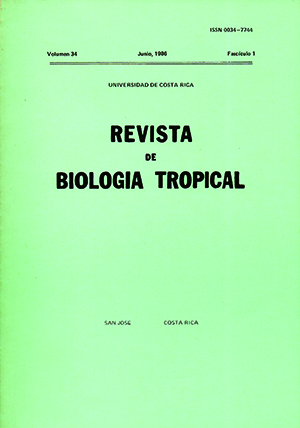Resumen
Se analizó la abundancia, distribución y ámbito de profundidad de las plantas acuáticas en el Lago Yojoa. Se identificó 31 especies de angiospermas, 3 macro-algas y 2 pteridófitas adaptadas a la vida acuática. Vallisneria sp. es la especie sumergida dominante y de distribución más amplia excepto en la orilla Sur, y la de mayor ámbito de profundidad.
Las diferencias en la distribución de ciertas especies entre la orilla Norte y Sur se deben al efecto mecánico de los vientos predominantes Norte-Sur que desprenden y depositan el material vegetal flotante en la orilla Sur, concentrando el problema de la eutroficación a una sola orilla. La diferencia entre las orillas Este y Oeste con respecto a las plantas acuáticas estriba en las diferencias topográficas y del substrato y de las condiciones del bosque en las respectivas cuencas. El Lago Yojoa es un lago eutroficado con ligeras variaciones dependientes de la sección considerada, y la transparencia del agua es relativamente buena.
Las plantas flotantes que han ocasionado serios problemas en otros cuerpos de agua, no se consideran aquí como una amenaza, especialmente al proyecto hidroeléctrico del Lago. El control químico y mecánico de las malezas acuáticas, destruiría el hábitat óptimo de una gran parte de la cadena alimenticia del "Black Bass" (Micropterus salmoides).
Con la información disponible no se considera prudente ni necesario la introducción de peces exóticos o del manatí como medio de control biológico.
Citas
Atwood. W. W. 1933. Lake Atitlán. Bull. Geol. Soc. Amer. 44: 661-668.
Betancourth, J. A. & P. Dulin. 1978. Plan de uso múltiple del Lago Yojoa. Segunda fase. Proyecto interinstitucional. Re. Na. Re., 193 p.
Brinson, M. M. & F. G. Nordlie. 1975. II. Lakes. 8. Central and South America. Lake lsabal, Guatemala. Verth., Internat. Verein. Limnol. 19: 1468-1479.
Cattaneo, A. & J. Kalff. 1980. The relative contribution of aquatic macrophytes and their epiphytes to the production of macrophyte beds. Limnol. Oceanogr. 25: 280-289.
Cruz, G. A. 1979. Historia del Black bass, Micropterus salmoides en el Lago Yojoa. Ceiba, 23: 29-62.
Cruz, G. A. 1985. Biología del Black bass, Micropterus salmoides en el Lago Yojoa de Honduras. Rev. Lat. Acui. Lima-Perú. 23: 13-25.
Deevey, E. S. 1955. Studies in the tropics and southern hcmisphere. Limnological studies in Guatemala and El Salvador. Int. Verbo Thcor. Limnol. Verg. 12: 278-283.
Deevey, E. S. 1957. Limnologic studies in middle America, with a chapter on Aztec limnology. Trans. Conn. Acad. Arts Sci. 39: 312-328.
FAO & DIGERENARE. 1975. Plan de uso múltiple Lago Yojoa, primera parte. Grace, J. B. & R. G. Wetzel. 1981. Habitat partitioning and competitive displacement in cattails (Typha): experimental field studies. Am. Nat. 118: 463-474.
Harza Enginnering Co. 1978. Aquatic plant conditions in Lake Yojoa. Informe, 50 p.
Hutchinson. G. E. 1957. A treatise on limnology, vol III. John Wiley. New York, 571 p.
Juday, C. 1915. Limnological studies on some lakes in Central America. Trans. Wisc. Acad. Sci., Arts Lett. 18: 214-250.
Krecker, F. H. 1939. A comparative study of the animal population of certain submerged aquatic plants. Ecology 20: 553-562.
Pearsal, W. H. 1922. A suggestion as to factors influencing the distribution of free-floating vegetation. J. Ecol. 9: 241-253.
Pearsall, W. H. & P. Ullyott. 1934. Light penetration into freshwater. III. Seasonal variations in the light conditions in Windermere in relation to vegetation. J. Exp. Biol. 11: 89-94.
Problems of lake boil. A. A. A. S. Publ. 10: 107- 122. Science Press, Lancaster, Penn.
Pearsall, W. H. & T. Hewitt. 1933. Light penetration into freshwater. II. Light penetration and changes in vegetation limits in Windermere. J. Exp. Biol. 10: 306-312.
Reay, P. F. 1972. The accumulation of arsenic from arsenic rich natural waters by aquatic plants. J. Applied Ecol. 9: 557-565.
Rickett, H. W. 1924. A quantitative study of the larger aquatic plants of Green Lake. Wisconsin. Trans. Wisc. Acad. Sci., Arts. Lett. 21: 381-414.
Schmid, W. D. 1965. Distribution of aquatic vegetation as measured by line intercept with SCUBA. Ecology 46: 816-822.
Sheldon, R. B. & C. W. Boylen. 1977. Maximun depth inhabited by aquatic vascular plants. Amer. Midl. Nat. 97: 248-254.
Seddon, B. 1972. Aquatic macrophytes as limnological indicators. Freshw. Biol. 2: 107-130.
Spence, D. H. & J. Chrystal. 1970-a. Photosynthesis and zonation of freshwater macrophytes. I. Depth distribution and shade tolerance. New Phytol. 69: 205-215.
Spence, D. H. & J. Chrystal. 1970-b. Photosynthesis and zonation of freshwater macrophytes. II. Adaptability of species of deep and shallow water. New Phytol. 69: 21 7-227.
Spence, D. H. 1967. Factors controlling the distribution of freshwater macrophytes with particular reference to the lochs of Scotland. J. Ecol. 55: 147-170.
Wetzel, R. G. 1975. Limnology. W. B. Saunders Co., Philadelphia. 743 p.
Wilson, L. R. 1939. Rooted aquatic plants and their relation to the limnology of freshwater lakes. In
##plugins.facebook.comentarios##

Esta obra está bajo una licencia internacional Creative Commons Atribución 4.0.
Derechos de autor 1986 Revista de Biología Tropical


